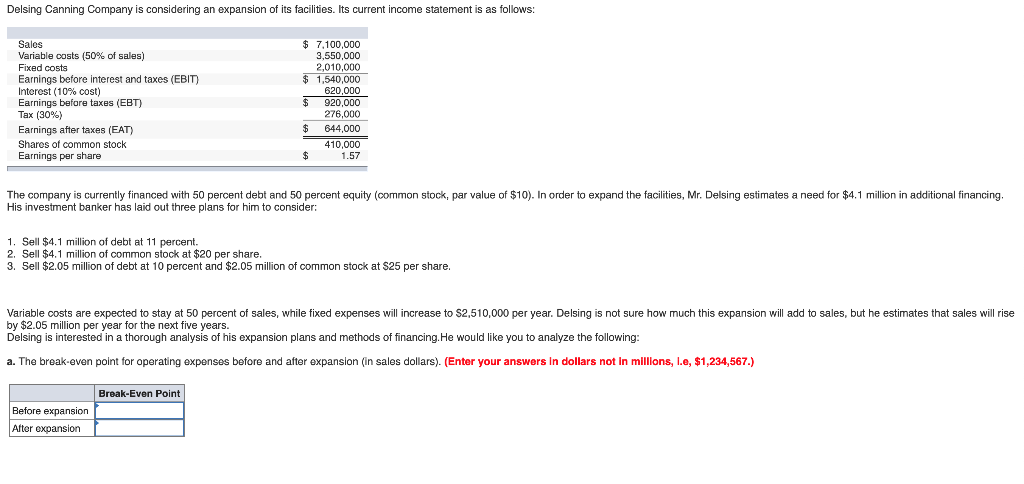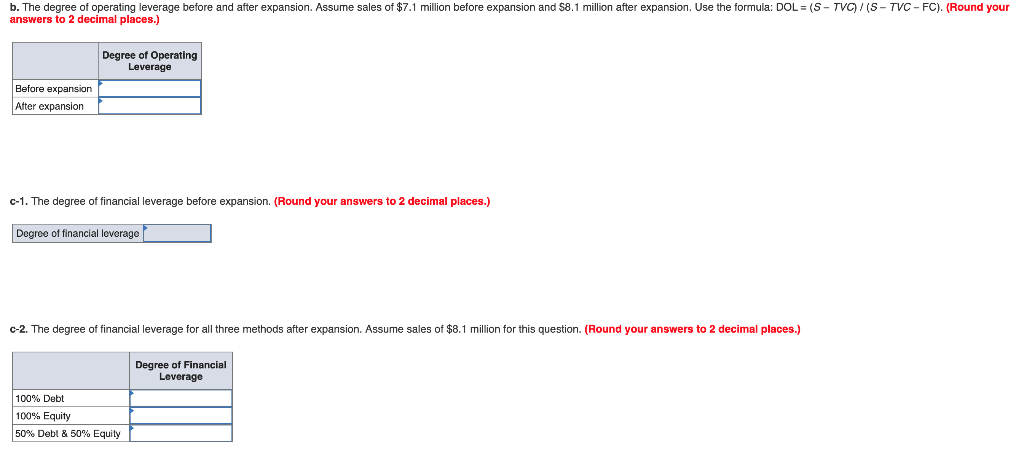


Delsing Canning Company is considering an expansion of its facilities. Its current income statement is as follows Sales Variable costs (50% of sales) Fixed costs Earnings before interest and taxes (EBIT) Interest (10% cost) Earnings before taxes (EBT) Tax (30%) Earnings after taxes (EAT) Shares of common stock Earnings per share $7,100,000 3,550,000 2,010,000 1,540,000 620,000 920,000 276,000 $644,000 410,000 1.57 The company is currently financed with 50 percent debt and 50 percent equity (common stock, par value of $10). In order to expand the facilities, Mr. Delsing estimates a need for $4.1 million in additional financing. His investment banker has laid out three plans for him to consider: 1. Sell $4.1 million of debt at 11 percent 2. Sell $4.1 million of common stock at $20 per share 3. Sell $2.05 million of debt at 10 percent and $2.05 million of common stock at $25 per share Variable costs are expected to stay at 50 percent of sales, while fixed expenses will increase to $2,510,000 per year. Delsing is not sure how much this expansion will add to sales, but he estimates that sales will rise by $2.05 million per year for the next five years. Delsing is interested in a thorough analysis of his expansion plans and methods of financing.He would like you to analyze the following a. The break-even point for operating expenses before and after expansion (in sales dollars). (Enter your answers In dollars not in millions, l.e, $1,234,567.) Break-Even Point Before expansion Alter expansion b. The degree of operating leverage before and after expansion. Assume sales of $7.1 million before expansion and S8.1 million after expansion. Use the formula: DOL-(S TVC) (S- TVC FC). (Round your answers to 2 decimal places.) Degree of Operating Leverage Before expansion After expansion c-1. The degree of financial leverage before expansion. (Round your answers to 2 decimal places.) Degree of financial leverage c-2. The degree of financial leverage for all three methods after expansion. Assume sales of $8.1 mlion for this question. (Round your answers to 2 decimal places.) Degree of Financial Leverage 100% Debt 100% Equity 50% Debt & 50% Equity d. Compute EPS under all three methods of financing the expansion at $8.1 million in sales (first year) and $11.0 million in sales (last year). (Round your answers to 2 decimal places.) Earnings per Share First Year Last Year 100% Debt 100% Equity 50% Debt & 50% Equity Delsing Canning Company is considering an expansion of its facilities. Its current income statement is as follows Sales Variable costs (50% of sales) Fixed costs Earnings before interest and taxes (EBIT) Interest (10% cost) Earnings before taxes (EBT) Tax (30%) Earnings after taxes (EAT) Shares of common stock Earnings per share $7,100,000 3,550,000 2,010,000 1,540,000 620,000 920,000 276,000 $644,000 410,000 1.57 The company is currently financed with 50 percent debt and 50 percent equity (common stock, par value of $10). In order to expand the facilities, Mr. Delsing estimates a need for $4.1 million in additional financing. His investment banker has laid out three plans for him to consider: 1. Sell $4.1 million of debt at 11 percent 2. Sell $4.1 million of common stock at $20 per share 3. Sell $2.05 million of debt at 10 percent and $2.05 million of common stock at $25 per share Variable costs are expected to stay at 50 percent of sales, while fixed expenses will increase to $2,510,000 per year. Delsing is not sure how much this expansion will add to sales, but he estimates that sales will rise by $2.05 million per year for the next five years. Delsing is interested in a thorough analysis of his expansion plans and methods of financing.He would like you to analyze the following a. The break-even point for operating expenses before and after expansion (in sales dollars). (Enter your answers In dollars not in millions, l.e, $1,234,567.) Break-Even Point Before expansion Alter expansion b. The degree of operating leverage before and after expansion. Assume sales of $7.1 million before expansion and S8.1 million after expansion. Use the formula: DOL-(S TVC) (S- TVC FC). (Round your answers to 2 decimal places.) Degree of Operating Leverage Before expansion After expansion c-1. The degree of financial leverage before expansion. (Round your answers to 2 decimal places.) Degree of financial leverage c-2. The degree of financial leverage for all three methods after expansion. Assume sales of $8.1 mlion for this question. (Round your answers to 2 decimal places.) Degree of Financial Leverage 100% Debt 100% Equity 50% Debt & 50% Equity d. Compute EPS under all three methods of financing the expansion at $8.1 million in sales (first year) and $11.0 million in sales (last year). (Round your answers to 2 decimal places.) Earnings per Share First Year Last Year 100% Debt 100% Equity 50% Debt & 50% Equity









